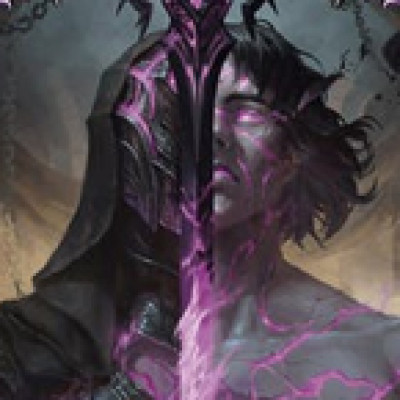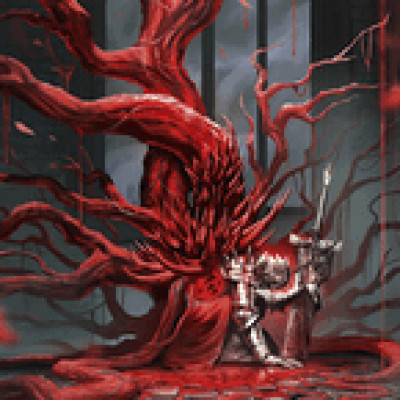Pro Tour: New Jersey is in the history books. It was an incredible event, with over 400 players vying to become the game's first Pro Tour Champion. I was ecstatic to get to be part of Flesh and Blood history and see if I had what it takes to win.
Of course, everyone wants to win the Pro Tour. That's the dream, right? But showing up to a tournament with a "1st place or bust" attitude is a great way to end up disappointed. I had two quantifiable goals for myself heading into the event: make Day 2, and make Top 32 (in order to snag a PTI).
At the end of the day though, my primary goal was to end the tournament feeling like I had played up to the level that I knew I was capable of playing. Variance exists, and sometimes the cards don't cooperate, so ending a game knowing you gave yourself the best opportunity to win is really all you can do. As a famous captain said, "It is possible to commit no mistakes and still lose". Losing I can handle, but I didn't want to finish the event feeling like I had beaten myself.
Joining the Chane Gang
Getting ready for the Pro Tour really started during the Pro Quest season. With Starvo bursting onto the scene, people scrambled to find good ways to combat the new top dog of the format, and the aura-heavy Prism builds that rose to prominence as a foil to Starvo.
As a Runeblade main, Chane was where I was initially drawn. Carrion Husk is an incredibly potent defensive tool that helps insulate against 'Casino' Starvo's fused attacks, the Eclipse package helps combat opponents aiming to fatigue, and Chane is aggressive enough to race most other decks in the format.
I played Chane for the first two weeks, but after falling just short of Top 8 a couple times, I switched to an aggressive build of Viserai, and with him I was able to secure an invite to New Jersey on the final weekend of events.
While initially I wasn't thrilled with the April 5th ban announcement pushing off any action until May (I'm sure I wasn't the only person dying to theorycraft and explore an updated format), I have to admit that having some downtime between the end of the Pro Quest season and next ban announcement was really nice for taking a step back from the game to recharge. But when it became clear that Starvo would not hit Living Legend prior to the Pro Tour, LSS announced the bans early and the floodgates opened.
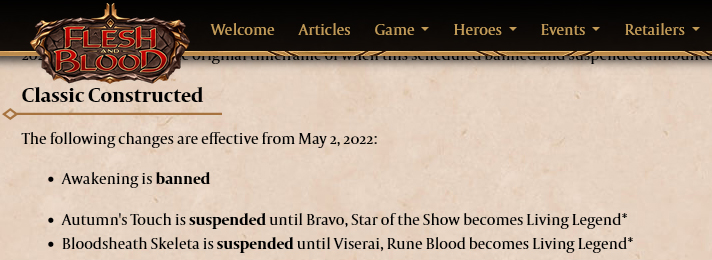
The Awakening ban and Autumn's Touch suspension made Starvo block worse and deprived him of his catch-up mechanic, which meant that aggression was back on the table. Conversely, the suspension of Bloodsheath Skeleta all but eliminated Viserai as an option for me at the PT. After the initial panic died down, it was apparent that Starvo was still very much a good deck, and my testing group's assumption was that the meta would be largely unchanged aside from Chane taking over Viserai's role as the third wheel to Starvo and Prism. Having quite a bit of experience playing Chane and zero desire to play Prism or Starvo, picking the Shadow Runeblade for the Pro Tour was a no-brainer.
The Deck
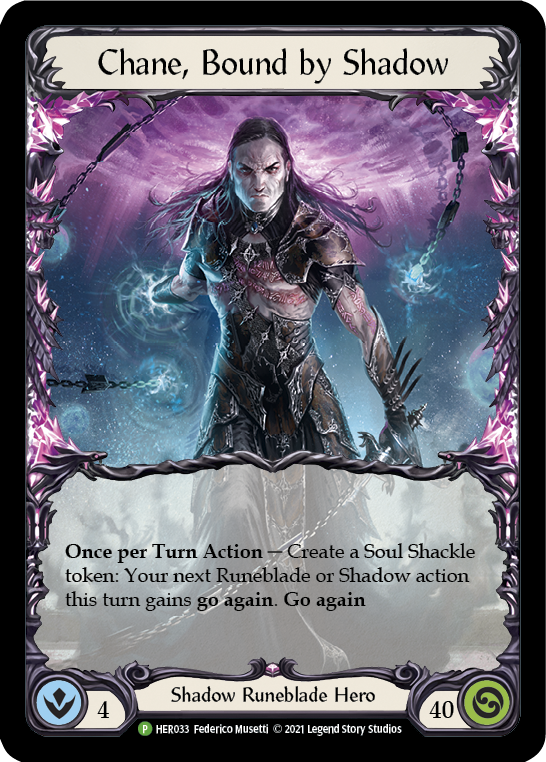
Weapons
- Rosetta Thorn (1)
Equipment
- Aether Ironweave (1)
- Carrion Husk (1)
- Arcanite Skullcap (1)
- Crown of Dichotomy (1)
- Grasp of the Arknight (1)
- Spellbound Creepers (1)
- Vexing Quillhand (1)
Loadout
- Art of War (Yellow) (3)
- Bounding Demigon (Blue) (3)
- Bounding Demigon (Red) (3)
- Enlightened Strike (Red) (3)
- Captain's Call (Yellow) (1)
- Captain's Call (Blue) (3)
- Eclipse (Blue) (1)
- Timesnap Potion (Blue) (3)
- Belittle (Red) (3)
- Mutated Mass (Blue) (1)
- Seeping Shadows (Yellow) (1)
- Seeping Shadows (Blue) (1)
- Shadow Puppetry (Red) (3)
- Bounding Demigon (Yellow) (3)
- Shrill of Skullform (Blue) (3)
- Howl from Beyond (Red) (3)
- Command and Conquer (Red) (3)
- Mauvrion Skies (Blue) (3)
- Minnowism (Red) (3)
- Shadow of Ursur (Blue) (3)
- Invert Existence (Blue) (2)
- Runic Reclamation (Red) (3)
- Shrill of Skullform (Yellow) (1)
- Vexing Malice (Blue) (3)
- Ghostly Visit (Red) (3)
- Minnowism (Blue) (3)
- Rift Bind (Red) (3)
- Soul Reaping (Red) (1)
- Unhallowed Rites (Red) (3)
When settling on my final 80 cards for the event, I had a few guiding principles that led me to where I landed- but ultimately, I aimed to keep it simple. I wanted to be a little heavier on blood debt to try and maximize Chane's natural card advantage, and I wanted to make sure I felt really good about the Eclipse anti-fatigue package.
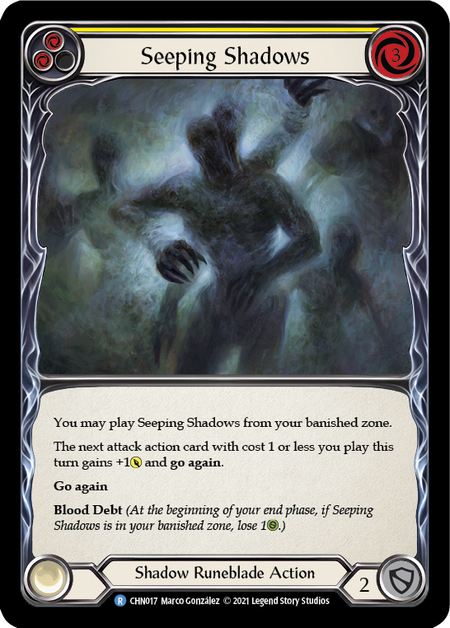

Running three Timesnap Potions was non-negotiable due to Prism and Oldhim (who I expected to see more of). Full sets of Command and Conquer and Runic Reclamation gave us some potent on-hit effects in a lot of aggro matchups, as well as a nice suite of phantasm poppers. An extra yellow Seeping Shadows rounded out the Eclipse package, providing a bit more redundancy for the big late game turns.
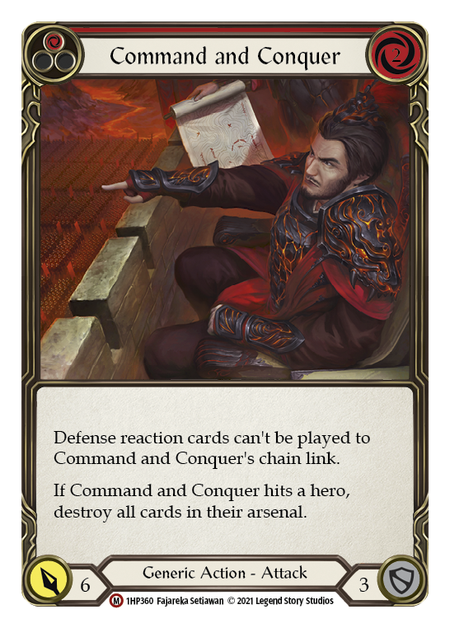
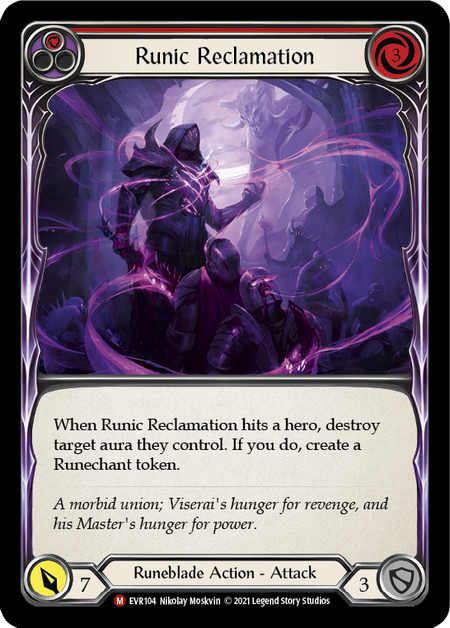
The end result was a 54 card core, with a sideboard of:
- Aether Ironweave
- Crown of Dichotomy
- Vexing Quillhand
- Command and Conquer x3
- Runic Reclamation x3
- Unhallowed Rites (Red) x3
- Minnowism (Blue) x1
- Invert Existence x2
- Seeping Shadows (Yellow) x1
- Seeping Shadows (Blue) x1
- Eclipse x1
- Timesnap Potions x3
Sideboarding
Against aggressive opponents who we will just be racing, we want to get down to our absolute best 60 cards for the matchup, since the game is not likely to last long enough for us to completely go through our deck. Into decks that will try and fatigue us, running more than 60 cards is perfect reasonable, as between Art of War, Belittle, Shadow Puppetry, and even Enlightened Strike we tend to draw several extra cards throughout the course of most games.
Aggro Opponents
Fatigue Opponents
Against Starvo, we needed to hedge, since we can't be certain if they'll try to race casino style or fatigue us with a more controlling Rampart loadout. Invert Existence we run to make it easier to put Ursur into play. If you are confident that your Starvo opponent is going to be on the fatigue plan, it'd be perfect reasonable to add some Timesnap Potions.
Since Prism tends to lose when she tries to race Chane, I felt pretty comfortable trading out Carrion Husk for Aether Ironweave to help make sure the Ursur turn happens on time. Prioritize getting a Timesnap Potion into play whenever reasonably possible, as it protects you against late Arc Light Sentinels.
Here we want every card that remotely makes sense. Timesnap potions shine here, and it's generally preferable to save Aether Ironweave for our Ursur turn to help insulate against the Oldhim Ice reaction.
The Pro Tour Event
Round 1: Viserai - W
Round 2: Boltyn - L
Round 3: Prism - W
Round 4: Starvo - W
Round 5: Starvo - W
Round 6: Starvo - W
Round 7: Kano - W
Round 8: Starvo - Draw
Round 9: Prism - W
Round 10: Chane - W
Round 11: Starvo - W
Round 12: Briar - W
Round 13: Prism - L
Round 14: Briar - L
Final Record: 10-3-1
If you had asked me at the start of the weekend if I'd be happy with that record, my answer would have been an emphatic "yes". After all, securing a PTI was my biggest "real" goal for the weekend, so of course I'd take that against the field of Pro Tour competitors. But context matters, and it's hard to not feel a tinge of disappointment at not being able to convert after starting 10-1-1. Being completely honest, I couldn't sleep that night. I think I was up until about 5 am, and I kept replaying the final two rounds in my head, second guessing myself and trying to find angles I missed or ways that I could have turned those losses into wins.
Fortunately for me, one of those matches was on stream, so the next day I decided to bite the bullet and watch. As a true devotee of the Demonastery, in true Chane self-flagellating fashion, I even read the twitch chat- which I must say only caused me to gain more respect and appreciation for the Flesh and Blood community, as the "worst" comment I saw was something to the effect of "these blocks are uncharacteristic of someone with a 10-3 record", with which I could not agree more. If you want to rewatch the match or follow along, the game is still available to watch here at 7:53:40. After going through the video myself, here are my thoughts:
- On the opening turn, I think I was too eager to hold onto the Runic Reclamation in my hand (probably due to some recency bias from getting to destroy a Channel Mount Heroic in my previous Briar match). I should have double blocked the first attack and then blocked whatever followed it accordingly, since every point of life counts. (Immediately drawing a second copy of Runic Rec also made me regret my decision in the moment, but that is results-oriented thinking and is less helpful for trying to improve.)
- On my second turn, I attacked with an unbuffed Rosetta Thorn for my third attack instead of the Rift Bind sitting in my banished zone. In non-aggro matchups, saving the Rift Bind for later would have made plenty of sense to get better value out of it. It also could have been reasonable to save it if I wasn't sure I'd have attacks to play on my next turn, but at this point I already had Runic Reclamation in my arsenal and the Bounding Demigon banished. Not using the Rift Bind here cost me an immediate 2 point life swing (+1 for Briar, -1 for me), plus potential extra blood debt damage in the future.
- On Briar's third turn of the game, I cashed in Husk to block a vanilla 7 damage attack with go again. At the time, I was at 25 life with my opponent at 23. He had one card left in hand, an arsenal, and 1 resource floating for Rosetta Thorn. Without a Channel Mount Heroic in play, the average Briar card is worth about 4 damage, so there was as much as 12 more damage heading my way. If I blocked 4 damage along the way with my non-Husk equipment, I could have been forced to Husk a 4 power attack in order to not just lose it for no value at the start of my turn. This was another time I was too attached to the Runic Reclamation in my arsenal, as I was set on a 4-card hand turn that could clear some blood debt and leave my emergency button there in case a CMH hit the battlefield. If I had played out my Rift Bind from banish the turn earlier, I might have been less concerned with needing to clear cards from banish, blocked with my yellow Bounding in hand, conserved my Husk for another turn, and still have come in for 14 with Runic Rec into Enlightened Strike.
- On Briar's fourth turn of the game, a lead off Sonata Arcanix for zero whiffed, and was followed by a Force of Nature fused with a Tome of Harvests. Entwine Lightning came in for 5 with go again from the Embodiment of Lightning, threatening to draw a card if it hit. I was at 18 with a hand of blue Vexing Malice, blue Mauvrion Skies, red Belittle, and red Minnowism. With the Runic Reclamation in arsenal and the Bounding Demigon in banish, I was looking at a 22 or 23 damage turn (depending on if the Runic Reclamation hit) with my opponent at 11. If I didn't need to Husk the turn earlier, the Entwine Lightning is a no brainer Husk block. But that wasn't the situation I was in, and I again went with the mental heuristic of each Briar card being worth about 4 damage, and decided I was okay with allowing the card draw since most of the attacks that could follow would likely be 4 damage into Rosetta Thorn.
I did not account for Enlightened Strike's ability to buff itself and threaten a second extra card (Swarming Gloomveil could also do this, albeit with a lower power) and it was perfect for the occasion. If it was another 4 or 5 damage attack threatening to draw a card, I would have two card blocked to stem the bleeding and live to fight another turn cycle. But blocking 7 would have eaten my entire turn, and I likely would have taken a minimum of 2 blood debt while not being able to present lethal, which I was confident would lose me the game. So I again eat the damage and give up the card draw, determined to make my 6 cards worth it.
Then another disaster strikes. Jacob not only has a blue to pitch for an extra Runechant before Rosetta, he also has another 0 cost attack for 4 with go again in the form of Revel in Runeblood, which forces me to use a blue from hand to stop the arcane from Rosetta to survive. I finally end up in the worst of both worlds, eating all the damage and still ending up unable to mount an effective turn on offense. I throw everything I can at him on my final turn, before succumbing to blood debt.
It's remarkable to see how each decision cascaded through the rest of the game. If I block out the opening turn Snatch, maybe Jacob has to arsenal a slightly worse card and I save a point of life. If I attack with the Rift Bind instead of Rosetta Thorn, maybe the life total difference makes me evaluate using Husk differently. If I don't Husk on Briar's third turn, I have it to use on the Force of Nature-buffed Entwine Lightning the following turn. Even with all those decisions, if I had played tighter and blocked out the initial Entwine Lightning with two cards (which I think was pretty clearly the better play), the game almost certainly goes another turn cycle and who knows what would have happened.
I am proud of myself for finishing in 11th place and for making a real run at Top 8. I also know that I have some clear areas for improvement in my game. It feels weird to say those two things back to back, but it's also exciting to think about. This is the best finish I've ever had at an event of this scale and I landed among some impressive company in that Top 16 and 32. This was an incredible weekend for Flesh and Blood, with many more sure to come. Pro Tour New Jersey was an unforgettable experience, but I think we're just getting started.
For now though, it's back to playing Pro Quests and waiting for Starvo and Chane to become Living Legends.
For anyone interested in the post-PT version of Chane I'll be taking to a handful of Season 2 Pro Quests, you can check it out here! This configuration should have all the same strengths as the PT version, while being a little better against Kano with the inclusion of Ebon Fold. It also doubles as a nice tool against fatigue opponents, as it allows you to tuck away your Eclipse in banish for later if it shows up in the early stages of the game. Since Chane will almost certainly not be CC legal beyond the release of Uprising, I'll be watching closely during spoiler season and looking to brew some Draconic goodness to bring to Road to Nationals.
Long live the Demonastery. See you all in France!


